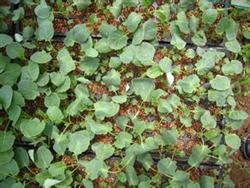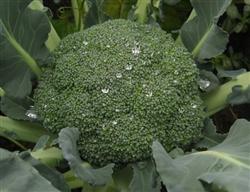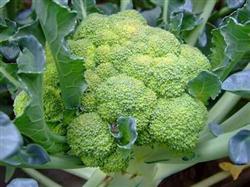Seedling raising technique of broccoli (broccoli)

Broccoli is the main vegetable export crop in Zhejiang Province. The planting area of broccoli is about 10000 hectares all the year round. However, because broccoli sowing season is in the period of high temperature and typhoon activity from July to September, how to make full use of the limited growing season to cultivate strong seedlings has become the key to broccoli production, processing and export trade. Xiangshan County Modern Agricultural Experimental Field, based on the tenet of technical breakthrough and service around leading industries, successfully cultivated 140 hectares of broccoli seedlings from 2001 to 2002, effectively solved the seedling problem for production. They are described as follows: 1. Requirements of broccoli seedling growth and development on environment The growth and development of broccoli seedlings includes three stages: germination stage, basic vegetative growth stage and rapid growth stage. Broccoli is a semi-cold-resistant vegetable. The lowest temperature for germination is 3℃, the optimum temperature is 20~25℃, the highest temperature is 35℃, the optimum temperature for plant growth is 20~22℃, and the flower bulb will be frozen at-5~-3℃. The flower bud differentiation is not strict to the low temperature, the early maturity variety can pass the flower bud differentiation as long as the average temperature is below 20℃, but the flower ball will be formed at the seedling stage and lose the commodity and reduce the yield. The temperature is lower than 8℃ and the growth is slow. The flower bud differentiation of middle and late maturing varieties requires low temperature, so they cannot be cultivated in high temperature season, otherwise they will form leaf-inserted flower balls, hairy flower balls and burnt buds. Therefore, broccoli has stricter requirements for sowing time. Broccoli requires plenty of light, but the length of the sun is not strict. It likes moisture, but it is not drought tolerant and waterlogging tolerant. It requires strict water, especially in seedling stage. Drought and waterlogging prevention are the key points of seedling management. Requirements seedbed soil loose, fertile, good water permeability. II. Seedling methods The seedling mode of broccoli is related to its variety characteristics and crop arrangement. In the east coast of Zhejiang Province, open field seeding, sunshade net covering, cooling and agricultural film covering are generally adopted to raise seedlings. III. Standards for strong seedlings Seedling age 30~35d, leaf age 5~6 true leaves, strong growth, no diseases and insect pests, thick stem, short internodes, large and thick leaves, normal leaf color, good root development, fibrous roots developed, plant growth neat. IV. Seed bed preparation 1. Seedbed selection broccoli seedlings should be selected high dry terrain, good drainage, ventilation and light transmission, rich in organic matter loose soil, and require nearly two years without cruciferous vegetables planted in the field as seedbed. Nursery requirements to 1:20 ratio to reserve sufficient seedbed. Cultivate the soil one week before sowing, apply 25kg of high-efficiency compound fertilizer per 667 square meters, apply deep fertilizer to the whole layer; the width of the seedling bed is 2m, the width of the furrow is 40~50cm, the height is 15~20cm, and the deep furrow is high; the seedling bed finishing requirements are coarse at the bottom and loose at the top, and the furrow surface is fine, flat and smooth. 2. Seedbed disinfection export broccoli seedlings should strictly implement the national vegetable pollution-free production operating procedures, seedbed disinfection select 25% redomil 500 times solution plus 40.7% lesben 800~1000 times solution spray seedbed before sowing for disinfection and sterilization and kill underground pests. 3. Chemical weeding before sowing In order to reduce the damage of weeds during seedling period and reduce the production cost of seedling, we can choose Dur herbicide with good safety and wide spectrum. The dosage is 70% Dur EC 20mL and water 15kg. Spray the surface of the bed before sowing, and water the seedbed thoroughly. 4. Regulation of soil moisture before sowing broccoli seedlings In the completion of the above work, we must adjust the soil moisture in the seedbed, too little soil moisture, affecting seed imbibition germination; too high humidity, it will cause soil gas rot seeds. Therefore, the principle of water regulation before sowing broccoli is that the surface of the soil is wet and the furrow is permeable, which can not only reduce the porosity between the soil and prevent the broccoli seeds from being deeply sunk to affect the emergence, but also prove that the degree of soil dryness and wetness is directly related to the emergence. V. Sowing 1. The main basis for determining a reasonable sowing date is variety characteristics, weather conditions and cultivation purposes. The sowing time of early maturing varieties such as Lufeng and Qingfeng was from the middle of July to the middle of August; the sowing time of early maturing varieties such as Excellent was from the first to the middle of August; the sowing time of medium maturing varieties such as Ludaizi and Marathon was from the last ten days of August to the first ten days of September; and the sowing time of late maturing varieties such as Meilu 90 and Fuxing was from the middle ten days of September to the first ten days of October. 2. To determine the reasonable sowing amount of broccoli seeds small, in order to ensure the number of seedlings in the field, and seedlings have sufficient growth space, it is necessary to scientifically calculate the amount of seeds in the field. The calculation formula is: seed dosage (g/667 square meters)=[number of seedlings/667 square meters ×(1+ safety factor)]× 1000-seed weight ÷ germination rate. The germination rate of qualified seeds was above 85%, and the safety coefficient of young seedlings was 80%. At present, the 1000-grain weight of the main varieties is 3.17g, Ludai 3.6g, Meilv90 5.56g, Chaoli 2.96g, Fuxing 3.94g. The seed amount for 667 square meters field was calculated as excellent 12g, green belt 15g, plum green 90 20g, Chaoli 12g and Fuxing 15g. 3. Sowing must be uniform, seedlings often use fine sand dressing dry seed direct seeding method, broccoli seeds evenly sown in the finishing of the seedbed. Sowing time should be selected sunny evening or cloudy day, general broccoli seeds after sowing do not use fine soil cover seeds, but take after sowing with fine spray nozzle to make seeds and ridge surface close contact method, and then cover 2~3 layers of shade net in the ridge surface to cool down moisture. VI. Seedbed management 1. It takes 2~3 days and nights to manage broccoli from sowing to emergence, which is short, but the management requirement is high. The key point should be to strengthen observation. From the overall environmental conditions of seedling stage, attention should be paid to adjusting the two main factors of temperature and moisture. During the whole germination period, field observations must be made three times a day in the morning, afternoon and evening to observe the germination of seeds, the dryness and wetness of the soil on the ridge surface, the intensity of sunlight or the drainage of the field in rainy days. Under the condition of high temperature in sunny days from July to September, the soil temperature was mainly regulated by watering during germination and emergence period, so that the soil temperature was kept at an appropriate temperature of 25~30℃, which was conducive to normal emergence. Watering can be carried out before noon and evening, try to avoid rainy weather after watering. During this period, the ridge surface is covered with a sunshade net for 2 to 3 days and nights to cool down and prevent rain, and the sunshade net is removed in time when the two cotyledons are unfolded and turned green after emergence. 2. Management of seedling basic vegetative stage The basic vegetative stage of broccoli seedling is from cotyledon turning green to 2 leaves and 1 heart stage. After cotyledon unfolding and turning green, broccoli seedling enters independent autotrophic stage. If root growth and absorption are poor, or the temperature in seedbed is too high, seedling growth and development are easy to be poor. With the growth and development of true leaves and the enlargement of leaf area, the function of cotyledons gradually lost after 2 leaves and 1 heart stage. The management of this period is the key to cultivate strong seedlings. Management mainly grasp the work of these aspects is a timely erection of small arch shed and covered with sunshade net. Sunshade net is covered from 8:00 a.m. to 4:00 p.m. on sunny days to cool down, and the sunshade net is removed at other times. On cloudy days and light rain, the net is not covered, and the intermittent net covering time lasts for one week. The second is to strengthen water management. After rain, clear the ditch and drain in time to ensure that there is no ponding in the field; when the soil surface is dry in sunny days, water it in time to preserve moisture. Third, prevent typhoons and rainstorms. Pay close attention to the forecast of typhoon, rainstorm and other bad weather. Before typhoon and rainstorm come, take various disaster prevention measures. Cover agricultural film on small arch shed, roll agricultural film with arch rod every 2m to form an air vent for ventilation and humidity reduction, hit a pressure film with pile head between every two arch rods, cover sunshade net on top of agricultural film and tighten and fix it with nylon rope or pressure film line. After typhoon and rainstorm, remove agricultural film and sunshade net in time to prevent seedling from overgrowth. Fourth, strengthen the prevention of diseases and insect pests. After emergence to 1 leaf 1 heart stage, 40.7% Lesben 800 times solution and 3% Jinggangmycin 500 times solution were used to prevent the damage of simian leaf worm and prevent the occurrence of blight and damping-off disease. 75% chlorothalonil 1000 times solution and 3% validamycin 500 times solution were used to prevent bacterial wilt and damping-off at the stage of 2 leaves and 1 heart. 3. Seedling rapid growth stage management seedlings enter rapid growth stage after 2 leaves and 1 heart stage, 90% of seedling growth is formed in this stage. At this time the temperature is still high, root formation, growth quickly, in order to cultivate strong seedlings, this period of management should be dominated by control. The management should focus on these aspects: First, continue to do a good job in typhoon and rainstorm prevention, and refer to the basic vegetative growth period of seedlings. Second, continue to do a good job of moisture management, dry rather than wet. Third, do a good job of thinning seedlings at the stage of 2 leaves and 1 heart, so that the seedling bed growth space reaches the uniform level of 10 square centimeters per plant, ensuring that 667 square meters of seedlings reach 50,000 plants. Fourth, control fertilization during the whole seedling growth period, but a small amount of urea can be applied to weak seedlings to promote balance. Fifthly, strengthen the control of insect pests. In the pest occurrence period, 5% Regent 1500 times solution can be used to control Plutella xylostella, cabbage caterpillar and cabbage moth; 20% Miman 1000 times solution plus 10% beta-cypermethrin 1500 times solution can be used to control Spodoptera exigua and Spodoptera litura; 10% imidacloprid 3000 times solution can be used to control aphids. VII. Seedling emergence and management After the above series of management measures, seedlings must be timely planted out of the nursery into the field when they have 5~6 leaves. 2 days before transplanting, apply fertilizer with a small amount of urea, check and control diseases and insect pests, and transplant seedlings with medicine, fertilizer and mud. Nursery irrigation when seedlings, to prevent root damage, and select consistent growth of large seedlings out of the nursery. After plucking seedlings, water them in time to facilitate the growth and development of the remaining seedlings. After the seedlings are cultivated for 1 week, they will become strong seedlings and leave the nursery.
- Prev

Planting techniques of precocious cauliflower
First, varieties with a growth period of more than 220 days should be selected and seeds should be mixed with new high-fat membrane. Second, the seedling bed must be shaded and moisturized. During the seedling period, insects should be treated every 7 days. Spraying new high-fat film at the seedling stage can prevent bacterial infection, improve the ability to resist natural disasters, improve the intensity of photosynthesis, and protect the seedlings from growing.
- Next

How to plant broccoli for high quality and high yield?
Broccoli, also known as broccoli, green cauliflower, with fleshy, fat and tender flower branches composed of flower balls for food, complete nutrition, high nutritional value, crisp and tender texture, refreshing and palatable, loved by consumers. Broccoli likes warm and cool climate, humid environment, anti-inflammatory heat, drought, not resistant to frost; the suitable temperature for seed germination is 15 Mel.
Related
- Where is it suitable to grow horseradish in China? it is expected to see the middle altitude horseradish in Alishan.
- How to prevent tomato virus disease reasonably? (Control methods included)
- Many people like to plant towel gourd on the balcony. What are the main points of this method and management?
- What crops can chili peppers be mixed with?
- Fertilization techniques and matters needing attention in Tomato
- What are the grafting techniques for peach seedlings in spring?
- Harm and control methods of root swelling disease of Chinese cabbage
- What are the pests of sweet potatoes? How to prevent and cure it?
- Symptoms, causes and Control methods of navel Rot in Tomato
- The cause of "Cucumber rotten bibcock" in Farmers' planting Cucumber and its Control Plan

